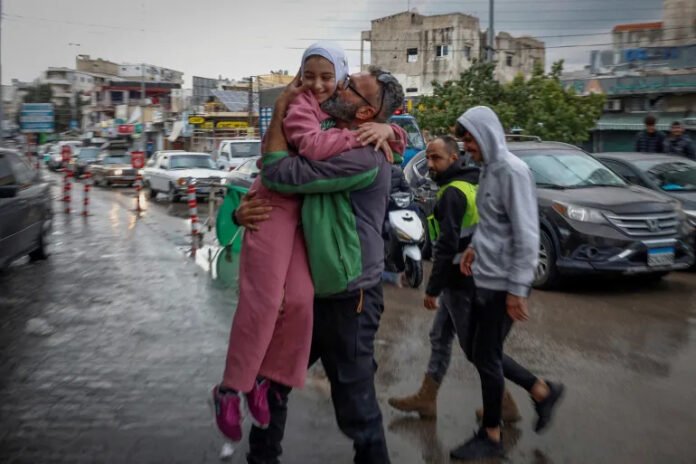Israel-Hezbollah Ceasefire 2024: Mirror of 2006: The hope of peace dawned on the prolonged Israel-Hezbollah conflict that devastated Lebanon and disrupted life in northern Israel. The United States and France brokered the ceasefire on November 27, 2024. The contours of this ceasefire largely mirror the 2006 UN Resolution 1701, which aimed to de-escalate the brutal month-long hostilities between Hezbollah and Israel.
Historically, lasting peace has remained elusive, disrupted in 1982, 2000, 2006 and 2024, casting apprehensions on the longevity of the present ceasefire. The latest truce may thus be a temporary pause till Hezbollah rises from current shock and strikes again, and Israel prevails over the war on Hamas to focus on Lebanon again.
Hezbollah is to withdraw 20 km north of the Litani River, with Israel withdrawing from southern Lebanon post above and the deployment of Lebanese forces and UN peacekeepers in a buffer zone. Stretching from East to West across much of south Lebanon, the Litani River is a crucial marker for a buffer zone that was once hoped would keep a ceasefire between Israel and Hezbollah. Israeli forces will maintain their positions, but a 60-day period will commence during which Lebanese military and security forces will deploy to the south.
This timeframe allows the Lebanese forces to reach Israeli positions, at which point Israel can begin a phased withdrawal without creating a power vacuum. Lebanese military, supported by UN peacekeepers, will replace Israeli troops south of the Litani River. This arrangement aligns with UN Security Council Resolution 1701, which seeks to strengthen Lebanese state authority while curtailing Hezbollah’s military influence.
Geopolitical Implication of the Peace Accord
The ceasefire agreement marks a significant thaw in the volatile Middle East landscape with profound implications for the actors and proxies behind the scenes.
A major shift this time is Hezbollah’s disassociating its actions in Lebanon with the linkage of Hamas’s operations in Gaza. The ceasefire’s terms not only expose Hezbollah’s vulnerabilities but also strain Iran’s broader strategy, compelling a reassessment of its regional ambitions. By effectively sidelining Hamas, Hezbollah and its Iranian patrons have tacitly acknowledged the constraints imposed by Israel’s overwhelming military response and US backing.
Israel has achieved significant goals by decimating the top hierarchy lineup of Hezbollah surgically, a goal never achieved at this scale ever before. Israel is also running low on war materials linked to restrictions on further supplies by the West and international pressures and needs to move from a two-front war to a single-front Hamas effort. The US is also increasing pressure with the escalatory dynamics of the Ukraine front, thus keen to quell the fire in the Middle East.
The ceasefire could indirectly bolster efforts to expand the Abraham Accord, a United States-led initiative normalising relations between Israel and several Arab states. An expanded framework might isolate Iran further, potentially setting the stage for a broader peace deal encompassing Palestinian statehood. However, this ambitious vision hinges on sustained international diplomacy and a genuine commitment to addressing longstanding grievances, particularly those of the Palestinians.
The ceasefire’s terms expose Hezbollah’s vulnerabilities and strain Iran’s broader strategy, compelling a reassessment of its regional ambitions. By sidelining Hamas, Hezbollah and its Iranian patrons have tacitly acknowledged the constraints imposed by Israel’s military response and US backing
Fragility of Peace: Will it Hold?
The Lebanon-Israel ceasefire underscores the region’s precarious balance between military deterrence and diplomatic engagement. While it temporarily halts a devastating conflict, the underlying tensions rooted in unresolved territorial disputes, asymmetric power dynamics, and external interference persist.
Another challenge remains the political instability in Lebanon and Hezbollah’s dual aspirations of a political party and militant organisation which complicate lasting peace. The Lebanese army’s capability to enforce the buffer zone remains doubtful, given its chronic underfunding and reliance on international aid. UNIFIL’s expanded role, including oversight by US and French representatives, introduces additional safeguards but stops short of addressing the root causes of the conflict.
Moreover, Israel’s conditional flexibility reserving the right to respond militarily to any perceived violations along with Hezbollah retaining significant military capabilities makes the peace fragile. Yet, there is a possibility for greater stability this time around given the fact that the ceasefire agreement also stipulates that, if and when it becomes permanent, the deal would serve as a basis for negotiations over the demarcation of the Israel-Lebanon territorial boundary.
Lebanese Model and Gaza Peculiarities
While the Lebanon ceasefire offers a framework for conflict resolution, applying its principles to Gaza requires a nuanced understanding of the differences between the two conflicts. Unlike Lebanon wherein Hezbollah operates within the framework of a recognised sovereign state, Gaza is governed by Hamas, which operates independently of the Palestinian Authority (PA). This fragmented governance structure presents a significant obstacle to implementing a unified security arrangement similar to Lebanon’s.
Further, Hezbollah’s extensive arsenal of advanced missiles and drones makes it a formidable regional actor that poses a major threat to Israel. Hamas, while also heavily armed, operates in a densely populated urban environment as a guerilla force, which complicates any attempts at military disengagement. While both Hezbollah and Hamas are proxies of Iran, their roles differ in scope and strategy. Hamas relies more on grassroots support within Gaza and the Palestinian diaspora while Hezbollah relies on Iran essentially. Mediating between Hamas and Israel due to ideological divides and Hamas’s designation as a terrorist organisation makes international and regional peace efforts more challenging.
The Lebanon ceasefire offers a framework to resolve the Gaza conflict but there is a difference between the two conflicts. In Lebanon, Hezbollah operates within the framework of a recognised sovereign state, whereas Gaza is governed by Hamas, which operates independently of the Palestinian Authority
Applying the Lebanon Framework to Gaza
To achieve a ceasefire in Gaza, stakeholders must adapt the principles of the Lebanon agreement to the peculiar realities and triggers of the Israeli-Hamas conflict. The hostage release issue remains central to the political survival and national psyche of Israel. Effective negotiations would require the involvement of regional and international powers, including Egypt, Qatar, the US, and the EU. These mediators must address both immediate security concerns and the long-term governance of Gaza. A phased withdrawal of Israeli forces, coupled with the deployment of a neutral security force, could help stabilise Gaza.
Unlike southern Lebanon, where territorial disputes are central, the Gaza conflict is deeply rooted in historical grievances and competing claims to sovereignty. Any lasting resolution needs to address the foundational issue of Palestinian statehood. Further, any agreement must prioritise the rebuilding of Gaza’s infrastructure and the return of refugees to their homes. This includes ensuring healthcare, education, and economic opportunities for the populace.
The Russia-Ukraine Connection
The Israel-Hezbollah ceasefire also creates hope for ongoing global conflicts, particularly the Russia-Ukraine war. While both conflicts reflect the human catastrophe and devastation, where proxy relationships play a significant role, their dimension, canvas and the root cause differ substantially.
Yet the ceasefire highlights the importance of multilateral diplomacy that could form the lines of peace efforts in Ukraine. The success or failure of the Lebanon ceasefire may influence perceptions of international mediation’s effectiveness, potentially shaping approaches to negotiations between Kyiv and Moscow. Additionally, the Middle East ceasefire draws global attention, potentially diverting diplomatic and material resources from Ukraine to the region at a time when Ukraine missile wars and nuclear brinkmanship were at the forefront.
The success or failure of the Lebanon ceasefire may influence perceptions of international mediation’s effectiveness, potentially shaping approaches to negotiations between Kyiv and Moscow. It also draws global attention, potentially diverting diplomatic and material resources from Ukraine to the region
The India-China Boundary Dispute Connect
India and China could adopt lessons from Lebanon by implementing phased troop withdrawals and diplomacy paving the way for resolving long-standing border disputes and mistrust bilaterally. This may sound utopian, but does kindle hope. The political dynamics influencing both disputes are notable yet exclusive; just as Hezbollah’s political role complicates Lebanon’s peace process, nationalist sentiments in India and China hinder compromises. Both countries could benefit from depoliticising the conflict, framing de-escalation as a shared goal for regional stability and economic growth.
The India-China dispute is entangled in strategic rivalries, including China’s competition with the US and India’s alignment with the Quad. While Lebanon’s ceasefire demonstrates the potential for incremental progress, challenges unique to the LAC, such as its complex terrain, asymmetry of power, and strong economic interdependence, necessitate tailored solutions. The ceasefire ultimately highlights the importance of diplomacy in conflict resolution, and pragmatic, phased approaches, offering a pathway for India and China to manage tensions, foster stability, resolve boundary disputes, and coexist amid ongoing rivalries.
Conclusion
The Israel-Hezbollah ceasefire represents a critical moment in Middle East geopolitics, offering a framework for conflict resolution that could inform adaptive yet peculiar approaches to Gaza. It is a reminder that even in the most entrenched conflicts, diplomacy remains a viable path to de-escalation and stability. Yet its fragility or longevity remains a million-dollar question that only time will answer. Even a short respite will bring succour to the region and the people.
The author, a PVSM, AVSM, VSM has had an illustrious career spanning nearly four decades. A distinguished Armoured Corps officer, he has served in various prestigious staff and command appointments including Commander Independent Armoured Brigade, ADG PP, GOC Armoured Division and GOC Strike 1. The officer retired as DG Mechanised Forces in December 2017 during which he was the architect to initiate process for reintroduction of Light Tank and Chairman on the study on C5ISR for Indian Army. Subsequently he was Consultant MoD/OFB from 2018 to 2020. He is also a reputed defence analyst, a motivational speaker and prolific writer on matters of military, defence technology and national security. The views expressed are personal and do not necessarily carry the views of Raksha Anirveda






